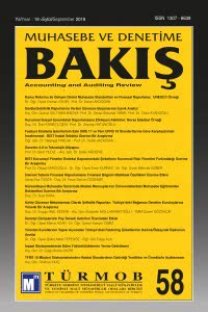ÇALIŞAN MORALİ VE İŞTEN AYRILMA İSTEĞİ: MUHASEBECİLİK MESLEĞİ ÜZERİNE BİR ARAŞTIRMA
Moral, işten ayrılma, muhasebecilik mesleği
WORKER MORALE AND INTENTION TO LEAVE: A RESEARCH ON ACCOUNTANCY OCCUPATION
Morale, intention to leave, accountancy occupation.,
___
- Abbott, Julie, “Does Employee Satisfaction Matter? A Study to Determine Whether Low Employee Morale Af- fects Customer Satisfaction and Profits in the Business-to-Business Sector”, Journal of Communication Ma- nagement, 2003, Volume 7, Number 4, s. 333-339.
- Baehr, Melanie E., ve Renck, Richard, “The Definition and Measurement of Employee Morale”, Administrati- ve Science Quarterly, 1958, Volume 3, Number 2, s. 157-184. Bluedorn, A., “The Theories of Turnover: Causes, Effects and Meaning”, Research in Sociology of Organisa- tions, Editör: Bacharach, S., JAI Press, Greenwich, CT, 1982. Brown, Craig, “Low Morale and Burnout; Is the Solution to Teach a Values-Based Spiritual Approach?”, Comp- lementary Therapies in Nursing & Midwifery, 2003, Volume 9, Number 2, s. 57-61.
- Caplow, Theodore ve McGee, Reece J., The Academic Marketplace, Basic Books, New York, 1958.
- Castledine, G., “What Has Happened to Morale in Nursing?”, British Journal of Nursing, 1997, Volume 6, Number 13, s. 773.
- Evans, Linda, “The Effects of Educational Change on Morale, Job Satisfaction and Motivation”, Journal of Educational Change, 2000, Volume 1, Number 2, s. 173-192. Field, Andy, “Factor Analysis Using SPSS”, http://www.sussex.ac.uk/Users/andyf/factor.pdf, 2005, Erişim Tari- hi: 13 Şubat 2008.
- Guba, Egon G., “Morale and Satisfaction: A Study in Past-Future Time Perspective”, Administrative Science Quarterly, 1958, Volume 3, Number 2, s. 195-209.
- Hair, Joseph F.Jr., Anderson, Rolph E., Tatham, Ronald L., ve Black, William C., Multivariate Data Analysis, 5th Edition, Prentice Hall, New Jersey, 1998.
- Hopkins, Hampton, “A Challenge to Managers: Five Ways to Improve Employee Morale”, Executive Develop- ment, 1995, Volume 8, Number 7, s. 26-28.
- Osborne, Jason W. ve Costello Anna B., “Best Practices in Exploratory Factor Analysis: Four Recommendations for Getting the Most From Your Analysis”, Practical Assessment Research & Evaluation, 2005, Volume 10, Number 7, s. 1-9.
- Jerome, Laurie ve Kleiner Brian H., “Employee Morale and Its Impact on Service: What Companies do to Crea- te a Positive Service Experience”, Managing Service Quality, 1995, Volume 5, Number 6, s. 21-25.
- Johnsrud, Linda K., Maintaining Morale: A Guide to Assessing the Morale of Midlevel Administrators and Faculty, Washington D.C.,: Collage and University Personel Association, 1996.
- Johnsrud, Linda K. ve Rosser, Vicky J., “Faculty Members’ Morale and Their Intention to Leave: A Multilevel Explanation”, The Journal of Higher Education, 2002, Volume 73, Number 4, s. 518-542.
- Kayış, Aliye, Faktör Analizi, SPSS Uygulamalı Çok Değişkenli İstatistik Teknikleri, Editör: Kalaycı, Ş., Asil Yayın Dağıtım: Ankara, 2006a.
- Kayış, Aliye, Güvenilirlik Analizi, SPSS Uygulamalı Çok Değişkenli İstatistik Teknikleri, Editör: Kalaycı, Ş., Asil Yayın Dağıtım: Ankara, 2006b.
- Lee, Thomas W. ve Mowday, Richard T., “Voluntarily Leaving an Organization: An Empirical Investigation of Steers and Mowday’s Model of Turnover”, Academy of Management Journal, 1987, Volume 30, Number 4, s. 721-743.
- Linz, Susan J., Good, Linda K. ve Huddleston, Patricia, “Worker Morale in Russia: An Exploratory Study”, Jo- urnal of Managerial Psychology, 2006, Volume 21, Number 5, s. 415-437.
- Litt, Mark D. ve Turk, Dennis C., “Sources of Stress and Dissatisfaction in Experienced High School Teachers?, Journal of Educational Research, 1985, Volume 78, Number 3, s. 178-185.
- March, James ve Simon, Herbert, Organizations, Wiley, New York, 1958.
- Matawatsakul, Nantaporn ve Kleiner, Brian H., “The Effects of Downsizing on Morale and Attrition”, Manage- ment Research News, 2003, Volume 26, Number 2/3/4, s. 52-62.
- McFadzean, Fiona ve McFadzean, Elspeth, “Riding the Emotional Roller-Coaster: A Framework for Improving Nursing Morale”, Journal of Health Organization and Management, 2005, Volume 19, Number 4/5, s. 318- 339.
- McKnight, Harrison D., Ahmad, Sohel ve Schroeder, Roger G., “When do feedback, incentive control, and au- tonomy improve morale? The importance of employee-management relationship closeness”, Journal of Mana- gerial Issues, 2001, Volume 13, Number 4, s. 466-482.
- Merenda, Peter F., “A Guide to the Proper Use of Factor Analysis in the Conduct and Reporting of Research: Pit- falls to Avoid”, Measurement and Evalutaion in Counseling and Development, 1997, Volume 30, Number 3, s. 156-164.
- Metzler, James C., “The Small Firm Advantage, Does Your Firm Have It?”, Journal of Accountancy, 2006, Vo- lume 202, Number 1, s. 61-63.
- Murnane, Richard J., Singer, Judith D., Willett, John B., Kemple, James J. ve Olsen, Randall J., Who will te- ach?: Policies That Matter, Harvard University Press, Cambridge, 1991.
- Sirota, David, Mischkind, Louis A. ve Meltzer, Michael I., “Assumptions That Kill Morale”, Leader to Leader, 2005, Number 38, 24-27.
- Smith, K. R., “Morale: A Refinement of Stogdill’s Model”, Journal of Educational Administration, 1976, Vo- lume 14, Number 1, s. 87-93.
- Sramcik, Tim, “The Five Myths of Employee Morale”, Aftermarket Business, 2006, November, s. 88-91.
- Tatlıdil, Hüseyin, Uygulamalı Çok Değişkenli İstatistiksel Analiz, Cem Web Ofset, Ankara, 1996.
- Weiss, Eileen M., “Perceived Workplace Conditions and First-Year Teachers’ Morale, Career Choice Commit- ment and Planned Retention: A Secondary Analysis”, Teaching and Teacher Education, 1999, Volume 15, Number 8, s. 861-879.
- Williams, G., Improving School Morale, Sheffield City Polytechnic/PAVIC Publications, Sheffield, 1986.
- ISSN: 1307-6639
- Yayın Aralığı: 3
- Başlangıç: 2000
- Yayıncı: TÜRMOB
RİSK ODAKLI İÇ DENETİM: TÜRKİYE’NİN 500 BÜYÜK SANAYİ İŞLETMESİNDE AMPİRİK BİR DEĞERLENDİRME
Hüseyin ERGİN, Tansel ÇETİNOĞLU, Niyazi KURNAZ
Şakir SAKARYA, H İbrahim ÖZMEN
YÖNETİM MUHASEBESİNDEKİ DEĞİŞİM VE DEĞİŞİMİ ETKİLEYEN FAKTÖRLER
KALİTE MALİYETLERİ VE YAŞAM BOYU MALİYETLEME YÖNTEMİ
Ercan BAYAZITLI, Yusuf KADERLİ, Eymen GÜREL
Fehmi KARASİOĞLU, Adnan AKGÜL, Alper Veli ÇAM
ÇALIŞAN MORALİ VE İŞTEN AYRILMA İSTEĞİ: MUHASEBECİLİK MESLEĞİ ÜZERİNE BİR ARAŞTIRMA
